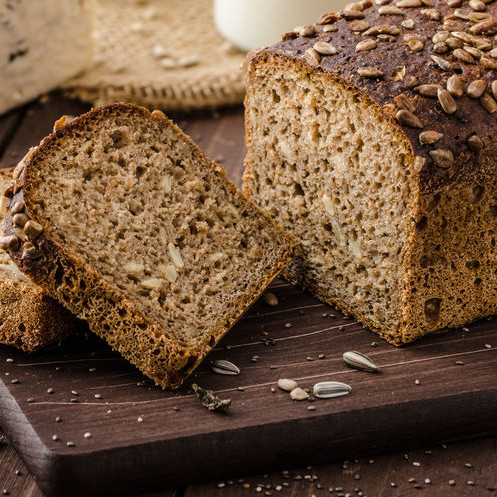
High Protein Bread
What is High Protein Bread?
High protein bread has been formulated and processed to comply with food labeling requirements for the nutrient content claims of:1,2
- “High in protein”
- “Rich in protein”
- “Excellent source of protein”
This claim requires that the finished product contains at least 20% protein per reference amount customarily consumed per eating occasion (RACC), or simply, 10 g protein per serving size of 50 g of product.1,2,3 In the U.S., the Daily Reference Value (DRV) for protein is 50 g per day. This is based on a reference caloric intake of 2,000 calories (for adults and children aged 4 years and older).4
How is high protein bread made?
To properly make high protein bread, the product is formulated with not just regular patent bread flour, but also by adding protein enriching ingredients that may be of plant or animal origin.
Protein enriching ingredients from plant sources:
- Whole grain cereals
- Semolina and durum wheat flour
- Ancient wheats
- Legumes or pulses (beans, soybean, lentils, dry peas, chickpea, lupins)
- Pseudocereals (quinoa, amaranth, buckwheat)
- Protein isolates, protein concentrates and hydrolysed forms
Protein enriching ingredients from animal sources:
- Whey protein
- Caseinates
- Protein isolates, protein concentrates and hydrolysed forms
- Eggs (whole eggs, egg whites) in liquid or dry form
Application
Formulation aspects to consider when using protein enriching ingredients:
- Protein content
- Source: allergenic nature, form (liquid or dry), composition (antinutritional factors)
- Acidity
- pH buffering effect
- Enzyme activity
- Microbial load
- Particle size (for dry forms)
Dough hydration should be increased as these ingredients also take up water, competing with bread flour for water absorption. The proper balance between protein contribution versus side effects on flavor, texture, color and shelf-life of finished product also needs to be adjusted for.
Operational aspects to consider when using protein enriching ingredients
Mixing:
- Mixing time may be decreased or increased depending on the type and amount of enriching ingredients.
- For whole grains of large a particle size, reduce the mixing tolerance of dough by exerting a cutting effect on the gluten structure.
- To prevent dough dry-out during makeup and to properly hydrate the whole grains, a soaking step with sufficient water should be performed for around 3–4 hours.
- Milk and egg solids increase the time it takes for the dough to fully hydrate. They also tend to increase dough stability.
Fermentation and Proofing:
- Yeast activity, production of aromas, flavors and gassing power may be enhanced if ingredients high in enzyme activity are added. In this case, fermentation and proofing times could be shorten.
- Yeast activity may be decreased if enriching ingredients buffer the pH change of fermenting dough. In this case, the optimum pH for yeast activity could not be reached quickly.
Makeup:
- Doughs formulated with considerable levels of whole grains and non-functional flours, lack elasticity and tend to be stiff, heavy and a bit dry. Such doughs intended for pan bread need to be moulded with more loose settings (e.g. roller gap, pressure board, side guide rails).
- Dusting flour is usually reduced as the dough is less sticky than regular bread doughs.
Baking:
- With a bulkier and heavier dough, it is recommended to extend bake times and decrease oven temperatures.
- Thermal profiling is essential for an optimum product quality and baking operation.
Practical example
A bakery wants to launch a new product: a whole wheat pan bread that has the claim “High in Protein.” The bakery management is wondering if this is possible. The company provides the following data:
| RACC for bread | Serving size (established by bakery) | Protein content (lab analysis) | Amount of protein per serving |
| 50 g | 1 slice (38 g) | 10.5% | 38 x (10.5/100) = 4 g |
According to this, the product cannot be labeled with the claim “high in protein” given that a serving only provides 8% of the DRV for protein (6 grams of protein per serving are needed to comply with the labeling requirements).
FDA regulation
There is no Standard of Identity for “high protein bread.” The Title 21, Part 101, Subpart D of the Code of Federal Regulations, establishes the specific requirements for nutrient content claims.
References
- CFR – Code of Federal Regulations Title 21, Part 101 Food Labeling, https://www.accessdata.fda.gov/scripts/cdrh/cfdocs/cfcfr/CFRSearch.cfm?CFRPart=101&showFR=1, Accessed 28 January 2019.
- Baldwin, N. “Health Claims on Food and Beverage Labels: Comparing Approaches in the EU and the USA.” Advances in Food and Beverage Labelling: Information and Regulations, Woodhead Publishing, Elsevier Ltd., 2015, pp. 87–110.
- Love, D.A. “Labelling requirements: European Union.” Food Labelling, Woodhead Publishing Limited and CRC Press LLC, 2000, pp. 59–61.
- Food and Drug Administration (FDA), US Department of Health and Human Services – Industry Resources on the Changes to the Nutrition Facts Label https://www.fda.gov/Food/GuidanceRegulation/GuidanceDocumentsRegulatoryInformation/LabelingNutrition/ucm513734.htm, Accessed 28 January 2019.

